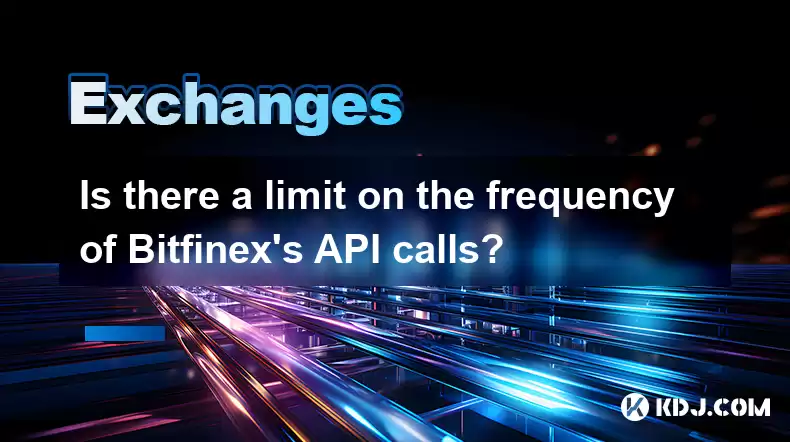-
 bitcoin
bitcoin $87959.907984 USD
1.34% -
 ethereum
ethereum $2920.497338 USD
3.04% -
 tether
tether $0.999775 USD
0.00% -
 xrp
xrp $2.237324 USD
8.12% -
 bnb
bnb $860.243768 USD
0.90% -
 solana
solana $138.089498 USD
5.43% -
 usd-coin
usd-coin $0.999807 USD
0.01% -
 tron
tron $0.272801 USD
-1.53% -
 dogecoin
dogecoin $0.150904 USD
2.96% -
 cardano
cardano $0.421635 USD
1.97% -
 hyperliquid
hyperliquid $32.152445 USD
2.23% -
 bitcoin-cash
bitcoin-cash $533.301069 USD
-1.94% -
 chainlink
chainlink $12.953417 USD
2.68% -
 unus-sed-leo
unus-sed-leo $9.535951 USD
0.73% -
 zcash
zcash $521.483386 USD
-2.87%
Is there a limit on the frequency of Bitfinex's API calls?
Bitfinex limits API calls to 90 per minute for authenticated users and 15 for unauthenticated, enforcing these limits with error codes and time windows.
Apr 13, 2025 at 03:28 am

Is there a limit on the frequency of Bitfinex's API calls?
When using Bitfinex's API, understanding the limitations on the frequency of API calls is crucial for developers and traders who rely on these services for trading, data analysis, and automation. Bitfinex, like many other cryptocurrency exchanges, imposes certain restrictions to ensure the stability and security of their platform. This article will delve into the specifics of these limits, how they are enforced, and what users can do to work within these constraints effectively.
Understanding Bitfinex's API Call Limits
Bitfinex's API is designed to handle a high volume of requests, but there are limits in place to prevent abuse and maintain system performance. The primary limit on Bitfinex's API is the rate limit, which restricts the number of API calls a user can make within a specific time frame. As of the latest information, Bitfinex imposes a rate limit of 90 requests per minute for authenticated API calls and 15 requests per minute for unauthenticated API calls.
Types of API Calls and Their Limits
Bitfinex categorizes API calls into authenticated and unauthenticated types. Authenticated API calls require user authentication and typically involve actions such as trading, withdrawing funds, or accessing personal account data. These calls are subject to the 90 requests per minute limit. Unauthenticated API calls, on the other hand, do not require user authentication and are used for fetching public data like market prices and order books. These calls are limited to 15 requests per minute.
How Rate Limits Are Enforced
Bitfinex enforces these rate limits using a system that tracks the number of API calls made by each user within a rolling window of time. If a user exceeds the allowed number of requests within this window, Bitfinex will return an error code indicating that the rate limit has been exceeded. The user must then wait until the time window has passed before making additional requests. This system ensures that no single user can monopolize the API resources, thereby maintaining fair access for all users.
Strategies for Managing API Call Limits
To effectively manage API call limits, users can adopt several strategies. One approach is to implement a delay between API calls to ensure that the rate limit is not exceeded. For example, if a user needs to make 90 authenticated API calls, they can spread these calls evenly over the minute, making one call every 0.67 seconds. Another strategy involves batching requests where possible. Instead of making multiple individual calls, users can combine requests into a single call, thus reducing the overall number of API calls.
Practical Example of Managing API Call Limits
To illustrate how to manage API call limits, let's consider a practical example of fetching market data using Bitfinex's API. Here is a step-by-step guide on how to do this while staying within the rate limits:
Initialize the API client: Start by initializing the Bitfinex API client using a library such as
ccxtin Python.import ccxtbitfinex = ccxt.bitfinex()
Fetch market data: Use the
fetch_tickermethod to get the latest market data for a specific trading pair, such as BTC/USD.btc_usd_ticker = bitfinex.fetch_ticker('BTC/USD')Implement a delay: To stay within the unauthenticated API limit of 15 requests per minute, implement a delay of at least 4 seconds between each call.
import timetime.sleep(4)
Fetch additional data: After the delay, fetch additional market data for another trading pair, such as ETH/USD.
eth_usd_ticker = bitfinex.fetch_ticker('ETH/USD')
By following these steps and implementing appropriate delays, users can effectively manage their API calls and stay within Bitfinex's rate limits.
Error Handling and Retry Mechanisms
When working with APIs, it's important to handle errors and implement retry mechanisms to deal with situations where rate limits are exceeded. If an API call returns an error due to exceeding the rate limit, the user should implement a retry mechanism that waits for the appropriate amount of time before attempting the call again. Here is an example of how to implement this in Python:
Implement error handling: Use a try-except block to catch any errors returned by the API.
try:btc_usd_ticker = bitfinex.fetch_ticker('BTC/USD')except ccxt.RateLimitExceeded as e:
print(f'Rate limit exceeded: {e}')Implement a retry mechanism: Use a loop to retry the API call after waiting for the necessary time.
import timemax_retries = 3retry_count = 0
while retry_count
try: btc_usd_ticker = bitfinex.fetch_ticker('BTC/USD') break except ccxt.RateLimitExceeded as e: print(f'Rate limit exceeded. Retrying in 60 seconds. Attempt {retry_count + 1}/{max_retries}') time.sleep(60) retry_count += 1
By implementing these error handling and retry mechanisms, users can ensure that their applications continue to function smoothly even when rate limits are exceeded.
Monitoring and Logging API Usage
To effectively manage API call limits, it's essential to monitor and log API usage. Users can implement logging mechanisms to track the number of API calls made and the time at which they were made. This information can be used to identify patterns and optimize API usage. Here is an example of how to implement logging in Python:
Initialize a logger: Start by initializing a logger to record API calls.
import logginglogging.basicConfig(filename='api_usage.log', level=logging.INFO)
Log API calls: Log each API call with the timestamp and the type of call made.
logging.info(f'Fetching ticker for BTC/USD at {time.time()}')btc_usd_ticker = bitfinex.fetch_ticker('BTC/USD')
By monitoring and logging API usage, users can gain insights into their API call patterns and make adjustments to stay within the rate limits.
Frequently Asked Questions
Q: Can I increase the rate limit for Bitfinex's API calls?A: Bitfinex does not typically allow users to increase the rate limit for API calls. The limits are in place to ensure the stability and security of the platform. However, users can optimize their API usage by implementing delays and batching requests to stay within the existing limits.
Q: What happens if I exceed the rate limit on Bitfinex's API?A: If you exceed the rate limit, Bitfinex will return an error code indicating that the rate limit has been exceeded. You will need to wait until the time window has passed before making additional requests. Implementing error handling and retry mechanisms can help manage this situation effectively.
Q: Are there different rate limits for different types of API calls on Bitfinex?A: Yes, Bitfinex has different rate limits for authenticated and unauthenticated API calls. Authenticated API calls are limited to 90 requests per minute, while unauthenticated API calls are limited to 15 requests per minute.
Q: How can I check my current API usage on Bitfinex?A: Bitfinex does not provide a direct way to check your current API usage through their API. However, you can implement logging and monitoring mechanisms in your application to track your API calls and ensure you stay within the rate limits.
Disclaimer:info@kdj.com
The information provided is not trading advice. kdj.com does not assume any responsibility for any investments made based on the information provided in this article. Cryptocurrencies are highly volatile and it is highly recommended that you invest with caution after thorough research!
If you believe that the content used on this website infringes your copyright, please contact us immediately (info@kdj.com) and we will delete it promptly.
- Curve Finance Charts Ambitious 2026 Development Roadmap with Landmark CRV Grant
- 2025-12-15 18:40:02
- K Korean CrWQ
- 2025-12-15 16:00:01
- Changpeng Zhao's Bold ASTER Investment Sends Ripples Through Cryptocurrency
- 2025-12-15 15:55:01
- UAE's Emerging Digital Landscape: Navigating Sports Wagering and iGaming Website Growth
- 2025-12-15 15:55:01
- StanChart, Coinbase Deepen Alliance: Charting a New Course for Institutional Digital Assets
- 2025-12-15 15:50:01
- Shiba Inu's On-Chain Signals: Decoding 2026's Potential Amidst Market Volatility
- 2025-12-15 12:35:01
Related knowledge

What does it mean to "Hedge" a position on Bybit and how do I do it?
Dec 11,2025 at 07:00pm
Understanding Position Hedging on Bybit1. Hedging on Bybit refers to opening opposing positions in the same trading pair to reduce exposure to adverse...

How to secure my Bybit account against phishing and scams?
Dec 12,2025 at 11:39am
Enable Two-Factor Authentication (2FA)1. Log in to your Bybit account and navigate to the Security Settings section. 2. Select Google Authenticator or...

What is the "Reduce-Only" option on Bybit and how does it prevent accidental orders?
Dec 15,2025 at 10:40am
Understanding Reduce-Only Mode1. Reduce-Only is a risk control feature on Bybit that restricts order execution to positions that only decrease or clos...

How to convert small balances ("dust") to another coin on Bybit?
Dec 07,2025 at 08:59pm
Understanding Dust Conversion on Bybit1. Dust refers to tiny, non-withdrawable balances of cryptocurrencies left in a user’s spot wallet after partial...

What are subaccounts on Bybit and why would I need to use one?
Dec 14,2025 at 06:00pm
Understanding Subaccounts on Bybit1. Subaccounts on Bybit are independent trading entities linked under a single master account, each with its own uni...

Why is the Bybit app not working or showing a connection error?
Dec 07,2025 at 06:00pm
Troubleshooting Network Configuration Issues1. The Bybit app relies heavily on stable internet connectivity to synchronize real-time market data and e...

What does it mean to "Hedge" a position on Bybit and how do I do it?
Dec 11,2025 at 07:00pm
Understanding Position Hedging on Bybit1. Hedging on Bybit refers to opening opposing positions in the same trading pair to reduce exposure to adverse...

How to secure my Bybit account against phishing and scams?
Dec 12,2025 at 11:39am
Enable Two-Factor Authentication (2FA)1. Log in to your Bybit account and navigate to the Security Settings section. 2. Select Google Authenticator or...

What is the "Reduce-Only" option on Bybit and how does it prevent accidental orders?
Dec 15,2025 at 10:40am
Understanding Reduce-Only Mode1. Reduce-Only is a risk control feature on Bybit that restricts order execution to positions that only decrease or clos...

How to convert small balances ("dust") to another coin on Bybit?
Dec 07,2025 at 08:59pm
Understanding Dust Conversion on Bybit1. Dust refers to tiny, non-withdrawable balances of cryptocurrencies left in a user’s spot wallet after partial...

What are subaccounts on Bybit and why would I need to use one?
Dec 14,2025 at 06:00pm
Understanding Subaccounts on Bybit1. Subaccounts on Bybit are independent trading entities linked under a single master account, each with its own uni...

Why is the Bybit app not working or showing a connection error?
Dec 07,2025 at 06:00pm
Troubleshooting Network Configuration Issues1. The Bybit app relies heavily on stable internet connectivity to synchronize real-time market data and e...
See all articles
























![Newbies buying Bitcoin for the first time: Complete guide, [Revealed] How to safely use Alipay to buy USDT, 2025 edition of practical tutorials on registration for OYE, virtual currency purchase, recharge and withdrawal practical collection (pictures and texts), BTC investment pitfalls: 5 key points to prevent being cheated Newbies buying Bitcoin for the first time: Complete guide, [Revealed] How to safely use Alipay to buy USDT, 2025 edition of practical tutorials on registration for OYE, virtual currency purchase, recharge and withdrawal practical collection (pictures and texts), BTC investment pitfalls: 5 key points to prevent being cheated](/uploads/2025/12/15/cryptocurrencies-news/videos/origin_693f604ff1171_image_500_375.webp)

















































